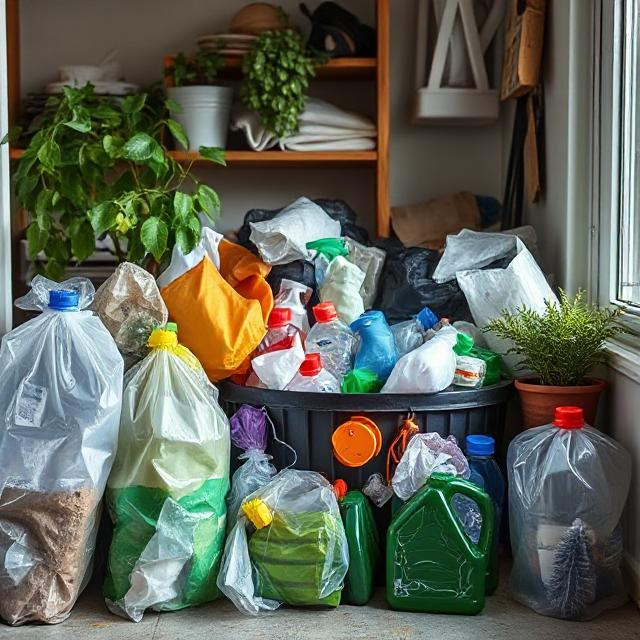How to Reduce Your Plastic Waste at Home: Tips for a Greener Lifestyle
In today’s world, plastic waste is everywhere—spreading across oceans, filling landfills, and contributing to pollution on a massive scale. If you’re looking to make a change and reduce your plastic waste at home, you’ve come to the right place. There are lots of small, easy adjustments you can make in your daily life at home that, collectively, will have a big impact. Here are some practical tips to help you get started on reducing your plastic footprint.
1. Say Goodbye to Disposable Napkins and Silverware
If you’re still using paper napkins and plastic silverware at your meals, it’s time to switch things up. Instead of reaching for a napkin that’s going to end up in the trash after one use, consider investing in reusable cloth napkins. They’re super easy to wash and can add a touch of charm to your dining table. Similarly, replace single-use plastic forks, knives, and spoons with reusable options made of stainless steel. The same goes for plates and cups—ditch the disposable plastic and invest in durable, reusable dinnerware that will last for years.
2. Store Leftovers in Glass Containers
Storing your leftovers in plastic containers is convenient and cheaper, but it’s also contributing to unnecessary plastic waste. Opt for glass containers instead, which are not only more eco-friendly but also safer for your health since they don’t leach harmful chemicals into your food. Glass is durable, microwave-safe, and can be used for years, making it a great investment. Plus, glass containers often have a more polished look that makes your leftovers feel like a special meal.
3. Avoid Ziploc Bags
Ziploc bags are another common household item that creates a lot of plastic waste. While they’re useful for storing food, they’re often used once and then tossed. Instead, try switching to reusable silicone bags. They’re just as handy as Ziploc bags, but you can wash them and use them over and over again. If silicone bags aren’t your thing, you can also try using glass jars or stainless steel containers for storing snacks, produce, or leftovers.
4. Use a Water Filter Instead of Bottled Water
We’ve all been there—reaching for a bottle of water when we’re thirsty. But buying bottled water is a huge contributor to plastic waste. Instead, invest in a water filter for your tap water. There are many affordable and effective options, like filter pitchers or under-sink systems, that will give you clean, fresh water without the plastic bottles. Not only will you reduce your plastic usage, but you’ll also save money over time.
5. Repurpose and Donate Old Toys and Clothes
If you have kids, you probably have a mountain of toys and clothes that they’ve outgrown. Instead of throwing them away, consider donating them to a local charity or repurposing them. Toys can be passed on to other children, and clothes can be given a second life through thrift stores or upcycled into something new. Repurposing old clothes into cleaning rags or quilts is also a great way to give them a new purpose. It reduces waste and keeps usable items out of the landfill.
6. Get Creative with Gift Wrapping
Gift wrapping is a fun tradition, but all that wrapping paper ends up in the trash. Why not get creative with items you already have at home? Use old newspapers, magazines, or fabric scraps to wrap your gifts. Not only will this reduce your paper waste, but it will also give your presents a unique, personal touch. You can also save gift bags and ribbons for reuse in the future.
7. Know What Goes in the Recycling Bin
Recycling is one of the easiest ways to reduce your plastic waste, but it’s important to know what belongs in the recycling bin and what doesn’t. Items like food containers or plastic bags often end up contaminating the recycling process, making it more difficult to recycle effectively. Familiarize yourself with your local recycling rules, and always make sure to rinse out containers before tossing them in the bin. Also, keep in mind that many items, like plastic wrappers, may not be recyclable at all, so it’s important to limit your use of these products when possible. If you want to learn about the different types of plastics, check out this article!
8. Buy in Bulk
One of the simplest ways to cut down on plastic packaging is to buy in bulk. Many stores now offer bulk bins for things like grains, nuts, and dried fruits. You can bring your own reusable containers or cloth bags to fill up, reducing the need for plastic packaging altogether. Plus, buying in bulk often saves you money!
9. Switch to a Bar Soap Instead of Liquid Soap
Liquid soap is typically sold in plastic bottles, but bar soap is a great plastic-free alternative. Bar soap works just as well for handwashing, body washing, and even shampooing, and it doesn’t require plastic packaging. It’s also often made with natural ingredients, which is a bonus for both you and the environment.
10. Grow Your Own Produce
If you have space, consider growing your own fruits and vegetables. Not only will this reduce your need to buy produce wrapped in plastic at the store, but it’s also a rewarding and sustainable way to feed your family. Even if you only have a small balcony, you can grow herbs or vegetables like tomatoes, lettuce, or peppers in pots.
Conclusion
Reducing your plastic waste doesn’t have to be overwhelming. By making small, thoughtful changes in your daily routine, you can drastically reduce the amount of plastic that enters your home and ends up in the landfill. Whether it’s switching to reusable dinnerware, ditching plastic bags, or learning more about proper recycling, every little bit helps. Together, we can all make a difference in reducing plastic waste and living more sustainably.
If you want to learn more tips, you can check out this website.

